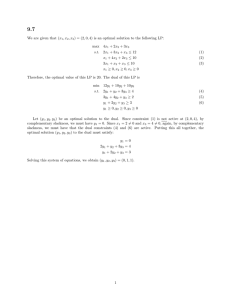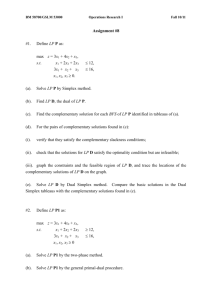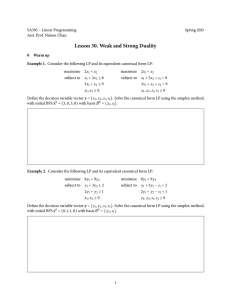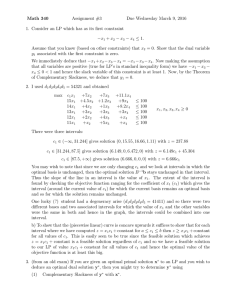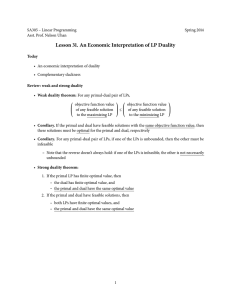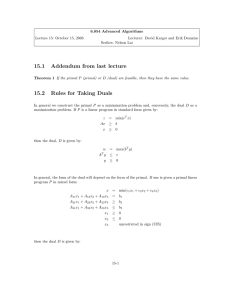MATH 340 Practice for Quiz # 3 Wednesday Feb. 3, 2016
advertisement
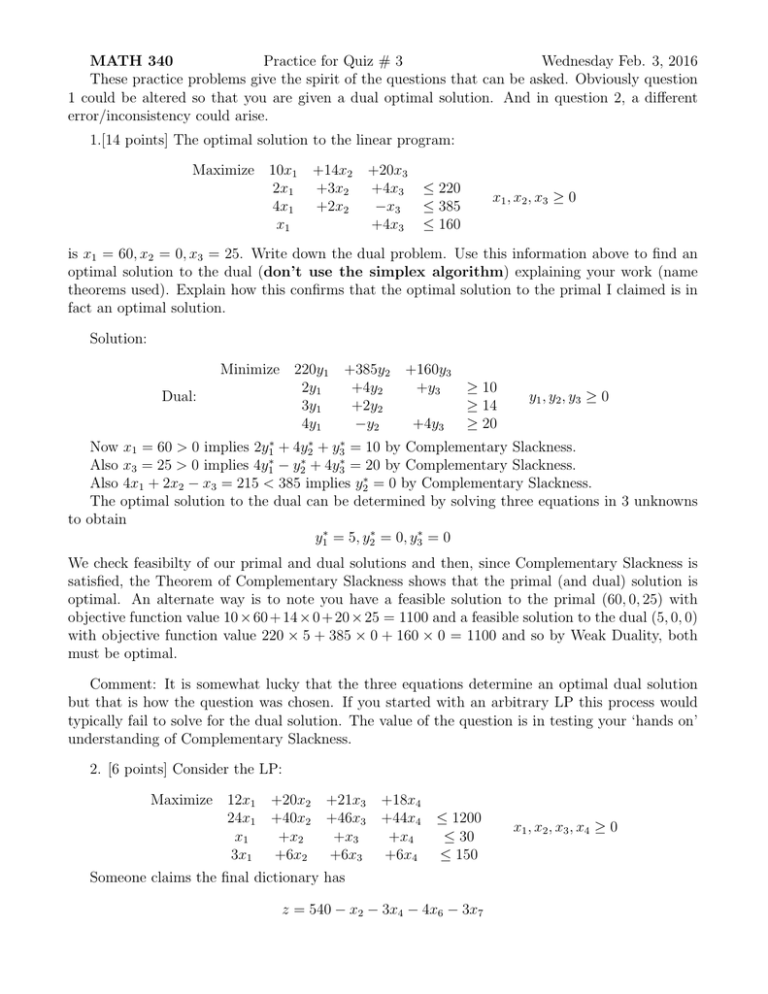
MATH 340 Practice for Quiz # 3 Wednesday Feb. 3, 2016 These practice problems give the spirit of the questions that can be asked. Obviously question 1 could be altered so that you are given a dual optimal solution. And in question 2, a different error/inconsistency could arise. 1.[14 points] The optimal solution to the linear program: Maximize 10x1 2x1 4x1 x1 +14x2 +3x2 +2x2 +20x3 +4x3 −x3 +4x3 ≤ 220 ≤ 385 ≤ 160 x1 , x2 , x3 ≥ 0 is x1 = 60, x2 = 0, x3 = 25. Write down the dual problem. Use this information above to find an optimal solution to the dual (don’t use the simplex algorithm) explaining your work (name theorems used). Explain how this confirms that the optimal solution to the primal I claimed is in fact an optimal solution. Solution: Dual: Minimize 220y1 2y1 3y1 4y1 +385y2 +4y2 +2y2 −y2 +160y3 +y3 +4y3 ≥ 10 ≥ 14 ≥ 20 y1 , y2 , y3 ≥ 0 4y2∗ + y3∗ y2∗ + 4y3∗ 2y1∗ 4y1∗ = 10 by Complementary Slackness. + Now x1 = 60 > 0 implies Also x3 = 25 > 0 implies − = 20 by Complementary Slackness. Also 4x1 + 2x2 − x3 = 215 < 385 implies y2∗ = 0 by Complementary Slackness. The optimal solution to the dual can be determined by solving three equations in 3 unknowns to obtain y1∗ = 5, y2∗ = 0, y3∗ = 0 We check feasibilty of our primal and dual solutions and then, since Complementary Slackness is satisfied, the Theorem of Complementary Slackness shows that the primal (and dual) solution is optimal. An alternate way is to note you have a feasible solution to the primal (60, 0, 25) with objective function value 10 × 60 + 14 × 0 + 20 × 25 = 1100 and a feasible solution to the dual (5, 0, 0) with objective function value 220 × 5 + 385 × 0 + 160 × 0 = 1100 and so by Weak Duality, both must be optimal. Comment: It is somewhat lucky that the three equations determine an optimal dual solution but that is how the question was chosen. If you started with an arbitrary LP this process would typically fail to solve for the dual solution. The value of the question is in testing your ‘hands on’ understanding of Complementary Slackness. 2. [6 points] Consider the LP: Maximize 12x1 24x1 x1 3x1 +20x2 +40x2 +x2 +6x2 +21x3 +46x3 +x3 +6x3 +18x4 +44x4 +x4 +6x4 ≤ 1200 ≤ 30 ≤ 150 Someone claims the final dictionary has z = 540 − x2 − 3x4 − 4x6 − 3x7 x1 , x2 , x3 , x4 ≥ 0 Explain what optimal solution to the dual this implies and explain why there must have been an error in the final row for z. Solution: Following our proof of the Strong Duality Theorem, and our comments on the magic coefficients, an optimal solution to the dual has yi∗ = −coefficient of the ith slack of the primal and so y1∗ = 0, y2∗ = 4, y3∗ = 3. But our supposedly optimal solution to the primal has z = 540 and yet 1200y1∗ + 30y2∗ + 150y3∗ = 570 which violates Strong Duality and so some error must have been made. There are a number of ways in which an error can be made including complementary slackness; youll have to hunt a little. An alternate problem would be to give the dictionary of phase one where we are maximizing w = −x0 and yet the dictionary tells us that the LP is unbounded. Comments: This quiz is asking you to be able to use our Duality Theorems with real numbers.
